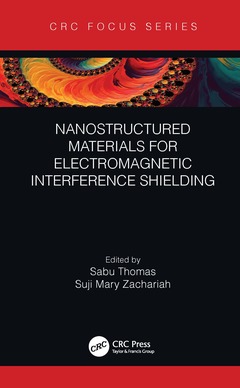Description
Nanostructured Materials for Electromagnetic Interference Shielding
Coordinators: Thomas Sabu, Zachariah Suji Mary
Language: English
Subjects for Nanostructured Materials for Electromagnetic...:
Keywords
Electromagnetic Interference Shielding; Carbon; EMI Shielding Material; Mxene; Effective EMI Shielding; Polymer; Shielding Materials; Absorption/Reflection; EMI Shielding Property; Biodegradable materials; EMI Shielding Efficiency; High-Temperature Materials; Reduced Graphene Oxide; Max Phase; EMI Shielding Application; EMI Shielding Performance; X-band Frequency Range; Em Radiation; PANI Film; Conducting Polymer; Go; Shielding Efficiency; Electromagnetic Shielding; Light Weight; EMI Shielding; Shielding Applications; Ring Opening Polymerization; rGO Composite; PPy; Intrinsically Conducting Polymers; GNP
· 13.8x21.6 cm · Hardback
Description
/li>Contents
/li>Biography
/li>
Electromagnetic interference (EMI) shielding materials prevent the transmission of electromagnetic (EM) radiation by reflection and/or absorption or by suppression. Emerging nanomaterials can be used effectively for EMI shielding. This book explores all aspects of EMI materials and focuses on the most recent advances and trends in the synthesis, processing, and characterization of electromagnetic shielding materials. Fundamentals of shielding theory, the practice of electromagnetic field measuring techniques, some of the EMI standards, novel materials employed (like MXenes), and the application of these materials in various fields are discussed.
Features:
- Provides a fundamental overview of EMI shielding and its effects on the environment and other electronics.
- Includes a comprehensive overview of the sources and effects of EM radiation.
- Explains the synthesis, characterization methods, and properties of materials used to protect against radiation.
- Gives insights into the physics of EMI shielding and its associated mechanisms.
- Examines the current state of the art and new challenges in this area.
This book is aimed at researchers and engineers working in the fields of electromagnetic interference shielding, polymer science, materials science, nanotechnology, and other allied subject areas.
1. An Overview on Electromagnetic Interference Shielding.
2. Carbon Materials: Potential Agents in Electromagnetic Interference Shielding.
3. Novel MXene Materials for Electromagnetic Interference Shielding Applications.
4. Biodegradable Thermoplastic Polymer Nanocomposites for Screening Electromagnetic Radiations.
5. Conducting Polymer-Based Materials for Electromagnetic Interference Shielding Application.
6. Absorption- and Reflection-Dominated Materials for Electromagnetic Interference Shielding Applications.
7. High-Temperature Materials for Electromagnetic Interference Shielding Applications.
8. Electromagnetic Interference Shielding Materials for Aerospace Applications.
9. Overview of Nanostructured Materials for Electromagnetic Interference Shielding Materials.
SUJI MARY ZACHARIAH
Miss. Suji Mary Zachariah is currently working as research scholar under the guidance of Prof. Sabu Thomas at Mahatma Gandhi University. She has expertise in polymer science and her research interests are in the field of polymer based nanocomposites for electromagnetic interference shielding application. She mainly works towards development of absorption dominated materials from sustainable resources and fabrication of several biopolymer composites with improved mechanical, electrical and shielding properties.
PROF. DR. SABU THOMAS
Professor Sabu Thomas is currently the Vice-Chancellor of Mahatma Gandhi University and the Founder Director and Professor of the International and Interuniversity Centre for Nanoscience and Nanotechnology. He was a full professor of Polymer Science and Technology at the School of Chemical Sciences, Mahatma Gandhi University, Kottayam, Kerala, India. Prof. Thomas is an outstanding leader with sustained international acclaims for his work in Nanoscience, Polymer Science and Engineering, Polymer Nanocomposites, Elastomers, Polymer Blends, Interpenetrating Polymer Networks, Polymer Membranes, Green Composites and Nanocomposites, Nanomedicine and Green Nanotechnology. Prof. Thomas has been conferred Honoris Causa DSc from the University of South Brittany, France, and University of Lorraine, France. Very recently he was awarded the Foreign Fellow of the European Academy of Sciences (EurASc) and was cited as top 2% of Scientists in India by Stanford University Professors. He received many national and international awards and he published over 1000 peer-reviewed research papers, reviews, and book chapters. He has co-edited 80 books and he is the inventor of more than 5 patents (granted- 4, filed -11).




